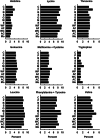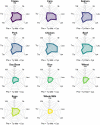The contribution of fisheries and aquaculture to the global protein supply
- PMID: 35075379
- PMCID: PMC8771179
- DOI: 10.1007/s12571-021-01246-9
The contribution of fisheries and aquaculture to the global protein supply
Abstract
The contribution of aquatic animal protein to the global, animal-source protein supply and the relative importance of aquaculture to capture fisheries in supplying this protein is relevant in assessments and decisions related to the future of aquatic food production and its security. Meat of terrestrial animals, milk, and eggs resulted in 76,966 Kt crude protein compared with 13,950 Kt or 15.3% from aquatic animals in 2018.While aquaculture produced a greater tonnage of aquatic animals, capture fisheries resulted in 7,135 Kt crude protein while aquaculture yielded 6,815 Kt. Capture fisheries production has not increased in the past two decades, and aquaculture production must increase to assure the growing demand for fisheries products by a larger and more affluent population. We estimated based on status quo consumption, that aquaculture production would need to increase from 82,087 Kt in 2018 to 129,000 Kt by 2050 to meet the demand of the greater population. About two-thirds of finfish and crustacean production by aquaculture is feed-based, and feeds for these species include fishmeal and fish oil as ingredients. Aquaculture feeds require a major portion of the global supply of fishmeal and fish oil. An estimated 71.0% of fishmeal and 73.9% of fish oil are made from the catch with the rest coming from aquatic animal processing waste. The catch of small, pelagic fish from the ocean is not predicted to increase in the future. Aquaculture should reduce its fishmeal and oil use to lessen its dependency on small wild fish important to the integrity of marine food webs and food security for the poor in many coastal areas. Fishmeal and fish oil shortages for use in aquaculture feed will result in a limit on production in the future if goals to lessen their use in feeds are not met.
Keywords: Animal feeds; Animal-source protein; Aquaculture production; Capture fisheries production; Global protein production; Resource use efficiency.
© The Author(s) 2022.
Conflict of interest statement
Conflict of interestThe authors declared that they have no conflict of interest.
Figures








References
-
- Action Against Hunger. (2021). World hunger: Key facts and statistics 2021. https://www.actionagainsthunger.org/world-hunger-facts-statistics
-
- Alasalvar C, Taylor KDA, Zubcov E, Shahidi F, Alexis M. Differentiation of cultured and wild sea bass (Dicentrarchus labrax): Total lipid content, fatty acid and trace mineral composition. Food Chemistry. 2002;79:145–150. doi: 10.1016/S0308-8146(02)00122-X. - DOI
-
- Alder J, Campbell B, Karpouzi V, Kaschner K, Pauly D. Forage fish: From ecosystems to markets. Annual Review Environmental Resources. 2008;33:153–166. doi: 10.1146/annurev.environ.33.020807.143204. - DOI
-
- Angell AR, Mata L, de Nys R, Paul NA. The protein content of seaweeds: A universal nitrogen-to-protein conversion factor of five. Journal of Applied Phycology. 2015;28:511–524. doi: 10.1007/s10811-015-0650-1. - DOI
-
- Argue BJ, Liu Z, Dunham RA. Dressout and fillet yields of channel catfish, Ictalurus punctatus, blue catfish, Ictalurus furatus, and their F1, F2, and backcross hybrids. Aquaculture. 2003;228:81–90. doi: 10.1016/S0044-8486(03)00245-X. - DOI
LinkOut - more resources
Full Text Sources
Miscellaneous
